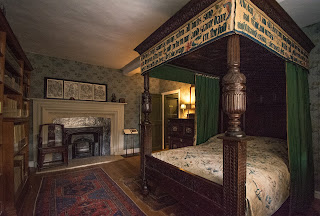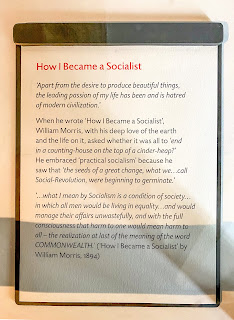William Morris at Kelmscott Manor
"Have nothing in your house that you do not know to be useful, or believe to be beautiful"
Tucked away in the Oxfordshire countryside lies Kelmscott Manor, once the family home of William Morris writer, designer and socialist William Morris, it was described by him as a "Heaven on Earth". He fell in love with the manor and surrounding farm buildings as a work of true craftsmanship. It is a place that is unspoilt and unaltered, in harmony with its surrounding countryside. Originally built around 1570 and with a late 17th century wing added, Kelmscott still retains that old world atmosphere and as you wander around the grade 1 listed buildings its not hard to imagine an earlier and more simple time.Morris aquired the manor in 1871 and it was his summer home until his death in 1896. After his death, his wife Jane and their daughter May bought the house and moved their possessions from their London home to Kelmscott Manor and continued to live there. When Jane died in 1914 the house passed to May who was also very active in the Arts & Crafts movement. Pre Raphaelite artist Dante Gabriel Rossetti was a co-tenant from 1871-76 and many of Rossetti's and Morris' friends and fellow artists spent time there. Some of the out buildings have also been carefully preserved and house an education centre, shop and cafe. booking in advance is recommended as the house is predictably popular. it really is a delightful place to visit.
Kelmscott Manor
One of the barns at Kelmscott. Now beautifully restored and converted into the shop.
The shop and some of the other out buildings at Kelmscott.
The back yard and dovecote.
Into the front garden.
A welcoming front door.
Interior at Kelmscott.
The Green Room
The dining room
One of the day rooms with Rossetti's painting of Jane Morris over the fireplace.
William Morris was born in this bed and it was bequeathed to him when his Mother died. It was a favourite of Jane Morris and it is seen here in her bedroom.
This is William Morris' favourite bed, in his bedroom. The embroidered bedspread was worked on by all of the family and as well as the main design, there are local scenes of the Thames, Kelmscott and surrounding area along its edges. He loved the bed so much that he wrote a poem for it and that is ebroidered around the canopy above the bed.
The wind is on the wold
And the night is cold,
And Thames runs chill
Twixt Mead and hill,
But kind and dear
is the old house here
And my heart is warm
'Midst winter's harm.
Rest then and rest,
And think of the best
'Twixt summer and spring,
When all the birds sing
In the town of the tree,
And ye in me
And scarce dare move,
Lest Earth and its love
Should fade away
Ere the full of the day.
I am old and have seen
Many things that have been,
Both grief and peace
And wane and increase
No tale I tell
Of ill or well,
But this I say:
Night treadeth on day,
And for worst or best
Right good is rest.
The attics rooms are fabulous and it was where the Morris children had their bedrooms and play areas.
Spiral staircases are often used as a space saving way to get from one level to another and the first of these two pictures shows the one Morris used to get up to the attic rooms. At the other end of the house id this unusual design shown in the second picture. Not quite a ladder, but not quite a staircase, it is another space saving way to get from one floor to the next.
A couple of tile designs by William Morris, on display at Kelmscott.
An upstairs window with its beautifully grained, original shutters.
The entrance to the church of St George, Kelmscott.
The final resting place in Kelmscott churchyard of William and Jane Morris.
From William Morris' pamphlet, 'How I Became A Socialist'.
"There is no square mile of Earth's inhabitable surface that is not beautiful in it's own way, if we men will only abstain from wilfully destroying that beauty."























